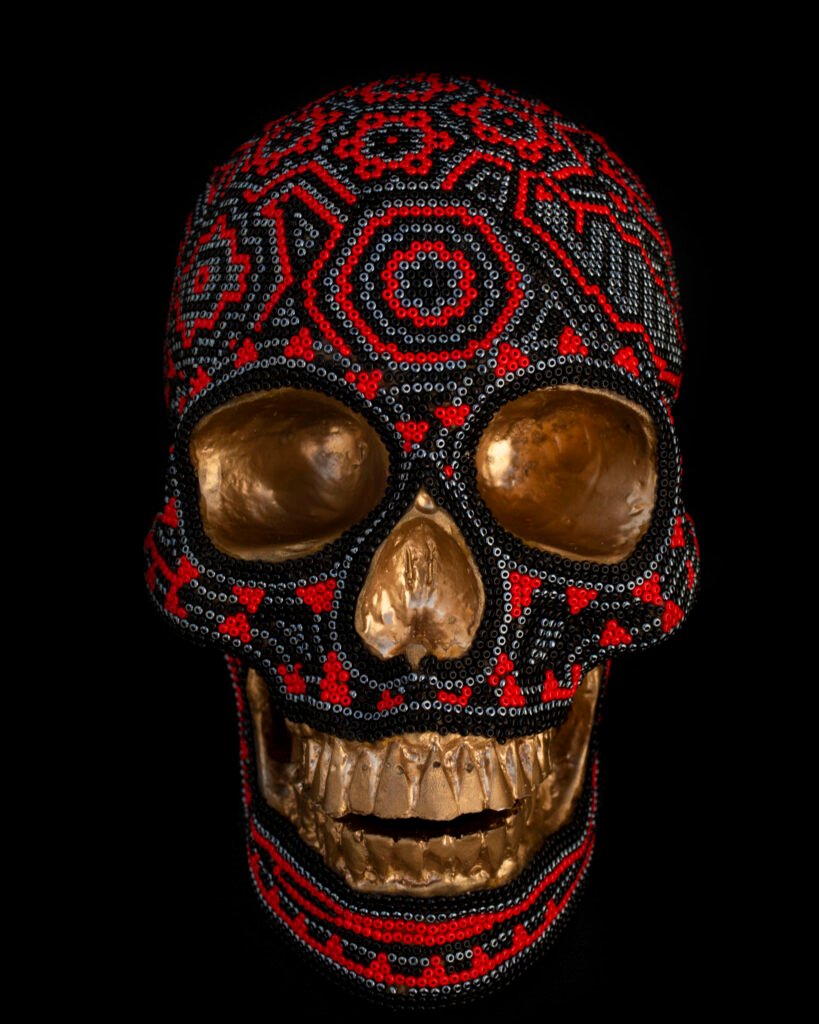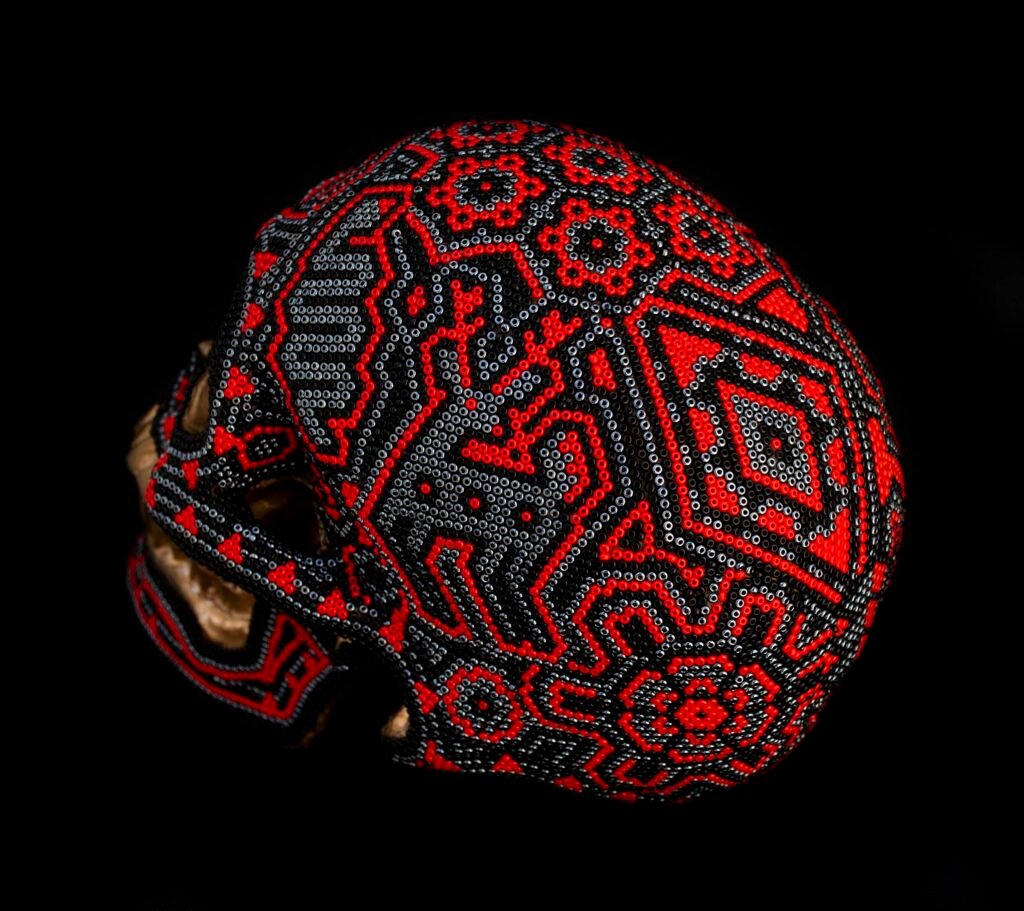
A Stunning Wixárika Skull: Tradition Meets Modern Artistry
The Wixárika, also known as the Huichol people, are renowned for their intricate beadwork and vibrant use of colors in their art. One particularly striking example of this craftsmanship is a Wixárika skull art piece. This piece is unique not only for its stunning design but also for the deep cultural significance it holds.
The Art Piece
This stunning Wixárika skull features a gold base, symbolizing the richness and vitality of life. Adorning this base are Czech chaquira beads in three bold colors: bright red, silver, and black. These colors are not chosen at random but are carefully selected to convey specific meanings and to create a visually captivating effect. The skull also has a movable jaw, adding a dynamic element to the piece, allowing the viewer to appreciate it with the jaw open or closed.

Symbolism and Meaning
The Wixárika people imbue their art with rich symbolism, often tied to their spiritual beliefs and cosmology. Here, the colors used play a vital role:
- Red: In Wixárika culture, red symbolizes life, blood, and the power of the gods. It represents the vitality and energy that is ever-present in the world around us.
- Silver: Silver beads often symbolize purity and the connection to the spiritual world. They reflect the light and are associated with the divine and sacred elements.
- Black: Black stands for the unknown, the mysteries of the universe, and the depths of the human soul. It is a color of respect and introspection.
The combination of these colors on the gold base creates a vibrant yet profound piece, blending the material richness of gold with the deep cultural meanings of the bead colors.

Craftsmanship and Technique
Creating such a piece requires immense skill and patience. The process begins with selecting high-quality Czech chaquira beads, known for their uniformity and brilliant colors. The artist then meticulously applies beeswax to the skull, which acts as an adhesive base for the beads.
Each bead is placed individually, following a predetermined pattern that often has spiritual or cultural significance. The artist’s steady hand and keen eye for detail are essential, as even a slight mistake can disrupt the intricate design.
The movable jaw adds another layer of complexity to the piece. This feature allows for interaction with the art, giving it a dynamic quality that can change the viewer’s perspective and experience of the piece.
Cultural Significance
For the Wixárika, art is not just a form of expression but a way to connect with their ancestors and the divine. Each piece of beadwork is a prayer, a story, and a piece of history. The skull, a symbol of mortality and the human experience is transformed into a vibrant testament to life and spirituality through the use of beads.
This skull also serves as a reminder of the Wixárika’s rich cultural heritage and their ongoing struggle to preserve their traditions in the face of modern challenges. By creating such art pieces, they continue to pass down their knowledge, beliefs, and artistic techniques to future generations.
This Wixárika skull, with its gold base and dynamic red, silver, and black beadwork, is a stunning example of the Huichol people’s artistic mastery and cultural depth. It is more than just an art piece; it is a bridge between the past and the present, the physical and the spiritual. The movable jaw adds a unique touch, making it a dynamic and interactive piece that captivates and inspires.
In appreciating this piece, one can gain a deeper understanding of the Wixárika’s worldview, their reverence for life, and their unwavering commitment to preserving their cultural identity through art.





This Wixárika skull is absolutely mesmerizing! The combination of the gold base with the red, silver, and black beads is striking. I purchase one similar and I love the movable jaw feature; it adds a unique touch to the piece. It’s now the centerpiece of my collection and always a conversation starter.
Wow, the detail on this Wixárika skull is incredible! The way the red, silver, and black beads contrast with the gold base is stunning. The movable jaw adds such a unique and interactive element. This piece truly showcases the remarkable artistry and cultural richness of the Huichol people.
I’m blown away by the beauty and craftsmanship of this art piece, I wish I could get one for my collection. The use of colors is so vibrant and captivating. The movable jaw feature is a fascinating addition. It’s amazing to see such a perfect blend of tradition and creativity in this Wixarika skull
What a stunning piece of art! The vibrant red, silver, and black beads against the gold base create a powerful visual impact. The movable jaw is such a creative feature. This Wixarika skull is a testament to the extraordinary skills and cultural heritage of the Huichol people.
I am truly amazed by this Wixarika skull. The meticulous beadwork and the striking color combination are mesmerizing. The gold base gives it a luxurious feel, and the movable jaw adds an interesting dynamic. It’s a beautiful piece that reflects the deep spiritual and cultural significance of the Huichol tradition.
This is one of the most beautiful art pieces I’ve seen! The attention to detail is incredible, and the colors are so vibrant and well-chosen. The movable jaw feature is a unique and engaging touch. This Wixarika skull is not just art; it’s a cultural treasure.